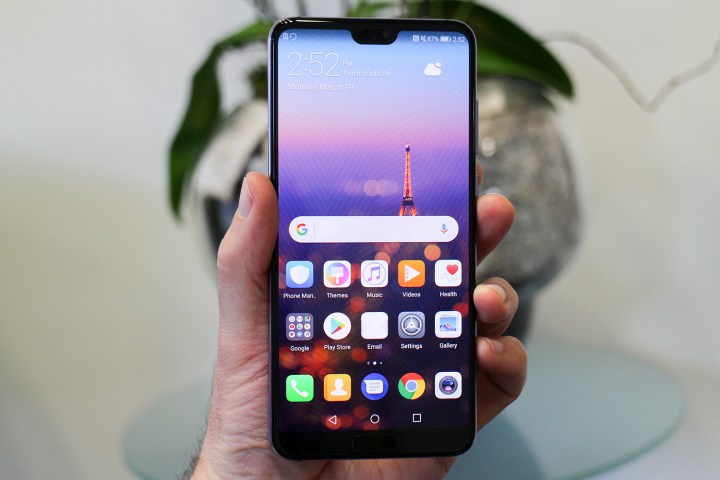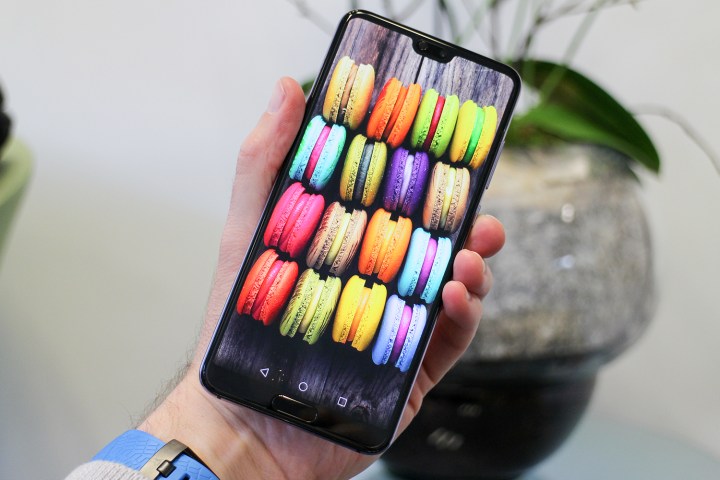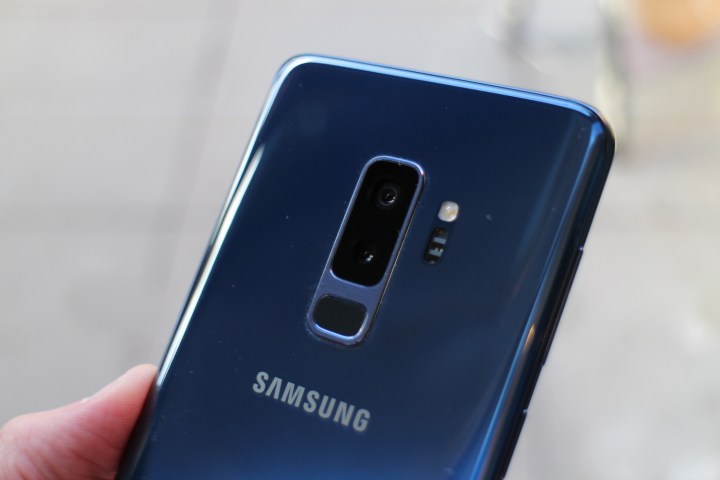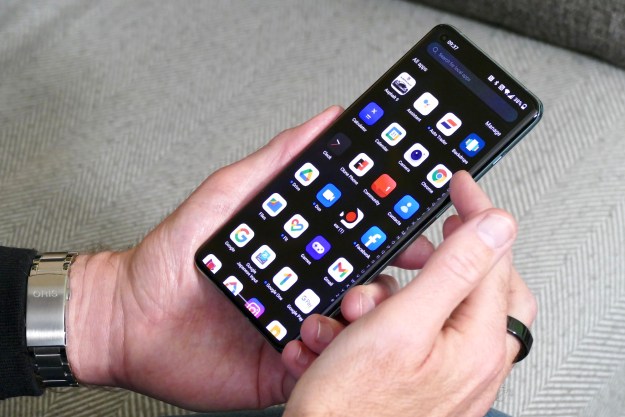Huawei has taken the wraps off its newest flagship, and the P20 Pro is the phone to snag if you’re looking for a new, powerful Huawei phone. But what’s that coming over the hill? It’s the Samsung Galaxy S9 Plus, and it’s angry at the P20 Pro for stealing its limelight. A conflict between the two is inevitable, but which will be left standing when these two clash? We took a look to find out.
Specs
| Huawei P20 Pro | Samsung Galaxy S9 Plus | |
| Size | 155 x 73.9 x 7.8 mm (6.1 x 2.9 x 0.3 inches) | 158.1 x 73.8 x 8.5 mm (6.22 x 2.91 x 0.33 inches) |
| Weight | 180 grams (6.34 ounces) | 189 grams (6.67 ounces) |
| Screen Size | 6.1-inch OLED display | 6.2-inch AMOLED display |
| Screen Resolution | 2,240 x 1,080 pixels (408 pixels per inch) | 2,960 x 1,440 pixels (529 pixels per inch) |
| Operating System | Emotion UI 8.1 (over Android 8.1 Oreo) | Samsung Experience 9.0 (over Android 8.0 Oreo) |
| Storage Space | 128GB | 64GB |
| MicroSD Card Slot | No | Yes, up to 256GB |
| Tap To Pay Services | Google Pay | Samsung Pay, Google Pay |
| Processor | Kirin 970 | Qualcomm Snapdragon 845 |
| RAM | 6GB | 6GB |
| Camera | Triple lens 40MP, 20MP, & 8MP rear, 24MP front | Dual lens 12MP rear, 8MP front |
| Video | 2,160p at 30 frames per second, 1,080p at 30fps, 720p at 960fps | 2,160p at 60 frames per second, 1,080p at 240 fps, 720p at 960 fps |
| Bluetooth Version | Bluetooth 4.2 | Bluetooth 5.0 |
| Ports | USB-C | 3.5mm headphone jack, USB-C |
| Fingerprint sensor | Yes | Yes |
| Water resistance | IP67 | IP68 |
| Battery | 4,000mAh | 3,500mAh |
| App Marketplace | Google Play Store | Google Play Store |
| Network support | T-Mobile, AT&T | T-Mobile, AT&T, Verizon, Sprint |
| Colors | Black, Blue, Twilight, Pink Gold | Midnight Black, Coral Blue, Lilac Purple |
| Price | $800 | $840 |
| Buy From | Huawei | Samsung |
| Review Score | 4.5 out of 5 stars | 4.5 out of 5 stars |
Performance, battery life and charging
The Huawei P20 Pro comes equipped with the powerful Kirin 970 we last saw in the Mate 10 Pro. Huawei has tuned it up a little for the P20 Pro, getting more out of the A.I.-centred NPU chip inside, and we expect to see good performance again. It’s beaten in sheer power by the Galaxy S9 Plus‘s Snapdragon 845, which saw exceptional results in our review benchmarks. Will that translate into better real-life performance? Despite the S9 Plus beating both the iPhone X and Pixel 2 in benchmarks, we found both of those phones to be smoother than the S9 Plus in real usage — so better benchmarks don’t necessarily mean better performance.
The Samsung Galaxy S9 Plus ships with the same 3,500mAh battery as the S8 Plus from last year. Heavy usage saw it drop to 25 percent by 6.30 p.m. after coming off the charger at 7.30 a.m. That’s not bad, but it’s far from the best performance around, and you may need to charge during the day if you’re a power user. Wireless charging is available, but the S9 Plus still only comes with QuickCharge 2.0, despite the Snapdragon 845’s QuickCharge 4.0 support.
We haven’t had a chance to properly test the P20 Pro’s battery, but we’re expecting the 4,000mAh battery to showcase similar performance to the Mate 10 Pro’s incredible battery life. With Huawei’s SuperCharge fast-charging tech, we expect the P20 Pro to be a superior performer in battery life and charging, but it lacks wireless charging support.
Until we get chance to test out the P20 Pro fully, these elements are too close to call. It’s a tie for now.
Winner: Tie.
Design and durability
Both of these phones are gorgeously designed glass-and-metal devices that look amazing. The Galaxy S9 Plus takes a lot of design cues from the S8 Plus, with the exception of some key decisions that fix some of our issues with the older design. The Huawei P20 Pro is similarly gorgeous, and you’ll find your eyes drawn to the lovely curves and shimmering finish — it’s utterly stunning. That said, the P20 Pro’s notch is a continued sore point in upcoming Android design, and we expect it to take some flack for that.
As these are both glass smartphones you’ll definitely want a case. A single bad bump could end up shattering either, and that’s not a good look. Thankfully they’re both more resistant to water, with the P20 Pro coming with an IP67 rating, while the Galaxy S9 Plus rocks a higher IP68 rating.
It’s clear that one phone here has a distinct edge over the other. With better water-resistance and our preferred design, the Galaxy S9 Plus takes it.
Winner: Samsung Galaxy S9 Plus
Display
You’ll find similar AMOLED display tech on both phones. The Huawei P20 Pro has a 6.1-inch display that boasts a 2,240 x 1,080-pixel resolution, while a higher 2,960 x 1,440-pixel resolution on the Galaxy S9 Plu’s 6.2-inch screen gives that phone the edge in sharpness. The vibrancy and deepness of colors, lights, and shadows is much the same, since both have top-of-the-line AMOLED displays.
With a slight edge in display sharpness, we have to give this to the Galaxy S9 Plus.
Winner: Samsung Galaxy S9 Plus
Camera
Both of these phones have been advertised heavily on the high standard of their cameras. The Galaxy S9 Plus comes with two 12-megapixel (MP) lenses and an aperture that mechanically changes to adjust to available light — the first such phone camera we’ve seen for many years. We’ve done many tests with its cameras, and have been suitably impressed with the results. The S9 Plus has been awarded high marks by camera specialists DxOMark too, likely making it one of 2018’s best camera phones, and setting the standard for the coming year of releases.
But the P20 Pro has an ace up its sleeve — Huawei has crammed three lenses onto the P20 Pro, and they’re all absolute monsters. The main lens sports a huge 40MP, and is joined by an 8MP telephoto lens. Below these two is a 20MP lens that shoots in monochrome, assisting low-light snaps. We’re yet to get a significant amount of time with the P20 Pro’s camera, but it’s proven to be an excellent system in the short time we’ve had with it. It could be the phone camera to unseat the Galaxy S9 Plus, but we’ll have to spend more time with it before we make that call.
It’s a tie on the video front, with both phones shooting super slow-motion at 960 frames per second, though the S9 Plus does have an edge as it is able to shoot at 60fps at 2,160p. In terms of selfie cameras, the S9 Plus’s 8MP front-facing camera is dwarfed by the 24MP monster on the front of Huawei’s phone, but unless you take a lot of selfies it will be hard to tell the difference.
There are too many variables to be able to call this yet, but we’re confident that the P20 Pro’s cameras will put up a worthy fight. It’s a tie for now.
Winner: Tie
Software and updates
Regardless of the phone you pick, you’re going to be using a heavily manufacturer-altered UI. The Galaxy S9 Plus comes with the Samsung Experience 9.0, while the P20 Pro runs Huawei’s Emotion UI (EMUI) 8.1. Both will be running Android Oreo, but only the Huawei device will have the latest Android 8.1 Oreo update applied at time of launch. Since they’re both running heavily modified UIs, you’re unlikely to get speedy Android updates on either phone.
Both UIs are pretty good, if heavy-handed, alterations of stock Android, and you shouldn’t expect prompt updates from either manufacturer.
Winner: Tie
Special Features

While the Mate 10 Pro had a desktop mode, the P20 Pro will not. On the other hand, the S9 Plus comes with Dex Station and Dex Pad support — but this will set you back at least another $100.
The P20 Pro’s has a Neural Processing Unit (NPU), which works as a dedicated processor for A.I. assistance. This manifests in a few different ways, suggesting camera modes and tracking subjects in the camera app, as well as a translation app. Huawei has big plans for the NPU, and we’re likely to see more of this in the P20 Pro.
We’re excited to see what more we get from the A.I.-assistance on the P20 Pro. It beats the expensive desktop mode on the S9 Plus.
Winner: Huawei P20 Pro
Price
The Samsung Galaxy S9 Plus is available from most U.S. carriers, with prices starting from $840. We’ve written a guide to buying the S9 and S9 Plus to help you make sure you’re getting the best deal.
The Huawei P20 Pro is expected to launch within the next month, but numerous setbacks mean that you won’t find this phone on any major U.S. networks, or at Best Buy. Still, you’ll be able to pick it up from Amazon — though it won’t be cheap. We expect the P20 Pro to be around $1,000 at launch.
The massive price difference for similar tech means that the Galaxy S9 Plus wins this round.
Winner: Samsung Galaxy S9 Plus
Overall winner: Samsung Galaxy S9 Plus
There’s a lot to love in the P20 Pro, and it might be our favorite Huawei device released so far, but there can only be one winner here. The Galaxy S9 Plus is the phone to beat at the start of 2018, and though the P20 Pro is definitely a contender, the S9 Plus simply represents better value for money, has a more powerful processor, and — for our money — is the better phone for you.
If you’re looking for a flagship phone with strong battery life or you’re a Huawei-head, then you can consider the P20 Pro your next major upgrade — but everyone else should pick the Galaxy S9 Plus.
Editors' Recommendations
- The Galaxy Tab S9 Ultra looks like one of 2023’s most exciting tablets
- Samsung’s Galaxy Tab S9 may get a feature the iPad has never had
- The best Samsung Galaxy Tab S8 Plus keyboard cases
- The best Samsung Galaxy S20 FE screen protectors for 2022
- Samsung’s self-repair program launches for Galaxy S21, S20, and Tab S7 Plus








